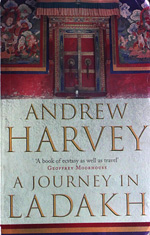Book Review: A Journey in Ladakh by Andrew Harvey

Title: A Journey in Ladakh
Author: Andrew Harvey
Publishers: Mariner Books
Pages: 260
‘A Journey in Ladakh’ is Andrew Harvey’s recollection of experiences from his visit to Ladakh.
Harvey has had a long standing interest in Buddhism, but had never heard of Ladakh. He first comes to know about the ancient Buddhist civilization of Ladakh in a corner of Delhi, where he is urged to make a journey to the remarkable mountain kingdom. When he listens to praises of Ladakh again somewhere in a Buddhist retreat in Sri Lanka, he makes up his mind and heads north. The book his full of his encounters with fellow travellers, local people, monks and rinpoches in the mountain country.
The book seems to wander aimlessly during the initial half and is full of random conversations and fragments of his memoirs that fail to form a good story. The author seems to be exaggerating or struggling for words when he describes his own experiences and feelings about the land and its people. The reader begins to feel that the book is no more than a journal of loosely coupled jottings of experiences of a journey in which Harvey describes about the difficulty of travelling in the bus to Leh, about his lodge owner and few talkative fellow tourists. While the book does hint about spiritual inclination of Harvey and the travellers he speaks to, the spiritual quest gains no significance until he meets a head lama.
However, a flow comes back into the book in the later half where Harvey starts getting deeper into the essence of Buddhism as he experiences and tries to understand the core values like love and compassion that form the foundation of every ritual, painting or celebration. He finds it easier than ever to connect with people in his surroundings as he is groomed by conversations with the monks. At times, he witnesses some strange local rituals and even goes through some metaphysical experiences. At the end of his journey, he is barely short of being a convert.
While his spiritual experiences and conversations with the lamas give a good direction to the book, it does feel as though the author has failed to carry his readers along with his experiences. Sometimes it appears as though the author goes through something that can’t be expressed in words, which may also make those experiences appear unreal or his narration limiting. His struggle with narration is evident in some occasions, especially when he describes the landscapes, paintings and some personal experiences in the monasteries. Many distractions in the book that come, such as conversations with his fellow travellers, makes the book slow paced. Yet, for someone interested in Tibetan Buddhism, this is an ideal book to understand the experiences of an outsider’s first brush with the religion.